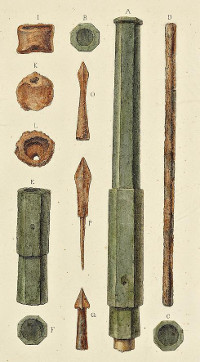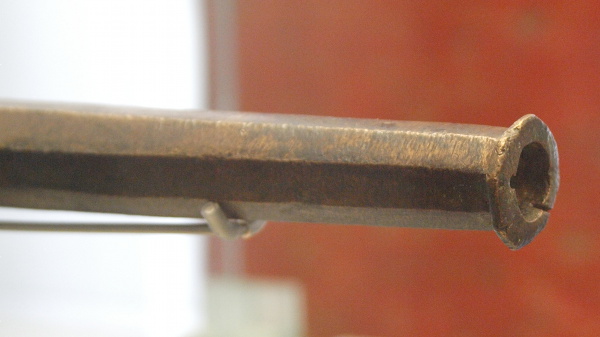
The best-known early firearm in the German-speaking world is the so-called Tannenberg Rifle.
During archaeological excavations in the runine of Tannenberg Castle near Seeheim-Jugenheim in Hesse, remains of three rifles were found in 1849: The barrel of a completely preserved bronze rod rifle, the fragment of a second bronze rod rifle with a broken barrel and a fragment of an iron rifle.1) Both bronze barrels were found in the backfill of the castle's cistern, but the excavators did not document any further details about the circumstances of the find or the situation. The bronze rifle fragment of Tannenberg Rifle 2 is now in the holdings of the Hessisches Landesmuseum in Darmstadt. The whereabouts of the iron rifle fragment are no longer known. The completely preserved Tannenberg Rifle 1 is kept in the Germanic National Museum in Nuremberg with the accession no. W2034; it is generally known as the "Tannenbergbüchse" (Tannenbeg rifle) in the scientific literature.2) Beside to the rifles, an iron ramrod was also found during the excavations, which would fit the rifles due to its dimensions, but nothing is known about its whereabouts today.3) Written records of the conquest and destruction of the robber baron's castle of Tannenberg by a detachment of the city of Frankfurt allow an exact dating of the rifles to the year 1399, which is why the Tannenberg Rifle is regarded as the oldest preserved and reliably dated firearm in Germany to date.
Tannenberg Rifle 1
 In the course of the past 150 years, the Tannenberg Rifle 1 has been scientifically published more than 20 times. The authors repeatedly presented widely diverging technical data, which suggests that they had not all inspected the rifle themselves or that they merely converted measurements from older literature incorrectly. For example, the calibre data range from 14.3 mm4) to 17.9 mm5) at the muzzle and from 14.6 to 16.8 mm in front of the chamber. The length of the flight was given between 154 and 165 mm. The diameter of the chamber ranges from 9.0 to 15.0 mm with powder chamber volumes of 7.2 to 13.8 cm³.3) The barrel of the rifle was made of bronze by casting. The flight and chamber do not run exactly centrally along the longitudinal axis of the barrel. The surface of the rifle has rough filing grooves, the surfaces are not really symmetrical to each other. The barrel was smoothed on the inside after casting and the chamber and flight are divided by a slight narrowing. The depression around the priming hole was not originally designed as a powder pan and may have been caused by burnout or corrosion when the rifle was used. Overall, the rifle appears to be rather carelessly crafted..5)
In the course of the past 150 years, the Tannenberg Rifle 1 has been scientifically published more than 20 times. The authors repeatedly presented widely diverging technical data, which suggests that they had not all inspected the rifle themselves or that they merely converted measurements from older literature incorrectly. For example, the calibre data range from 14.3 mm4) to 17.9 mm5) at the muzzle and from 14.6 to 16.8 mm in front of the chamber. The length of the flight was given between 154 and 165 mm. The diameter of the chamber ranges from 9.0 to 15.0 mm with powder chamber volumes of 7.2 to 13.8 cm³.3) The barrel of the rifle was made of bronze by casting. The flight and chamber do not run exactly centrally along the longitudinal axis of the barrel. The surface of the rifle has rough filing grooves, the surfaces are not really symmetrical to each other. The barrel was smoothed on the inside after casting and the chamber and flight are divided by a slight narrowing. The depression around the priming hole was not originally designed as a powder pan and may have been caused by burnout or corrosion when the rifle was used. Overall, the rifle appears to be rather carelessly crafted..5)
Technical Data
Overall length: 320,0 mm6)
Calibre: 15.16 mm6) (acc. to Wlassaty: 17.2–17.9 mm5))
Length of barrel: 286.4 mm max.5)
- thereof bore: 168.4 mm5)
- thereof chamber: 118.0 mm5)
Weight: 1,235 g6)

Tannenberg Rifle 2
The fragment of the bronze Tannenberg Rifle 2 has a length of approx. 110 mm and a diameter on the flat surfaces (flats) of 31.5-33.7 mm with a chamber diameter of 16.7 mm. The barrel has just broken off in the area of the powder chamber and contained no remains of a charge. The preserved rifle fragment is largely identical in form to the Tannenberg Rifle 1.3)
Einzelnachweise
- Hefner, Wolf (1850)
- Wlassaty (1999)
- Dannecker, Wlassaty (1981)
- Willers (1982): p. 435
- Wlassaty (1999): p. 982-983
- Objekt Nr W2034 in the object databas of Germanisches Nationalmuseum Nürnberg
Text and photos: Andreas Franzkowiak
